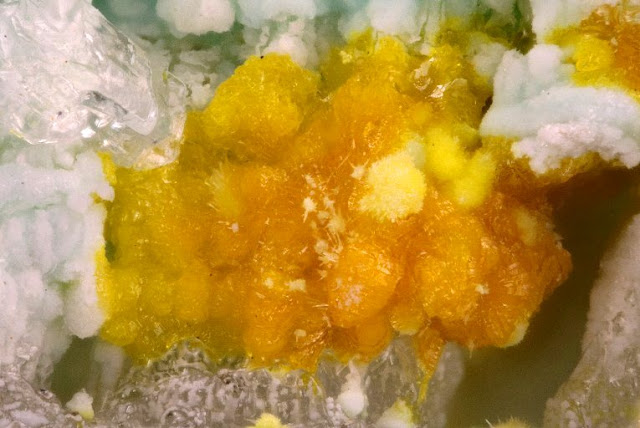Scientists found Three new uranium minerals In Utah
 |
| Uranyl minerals have distinct shiny colours even after the uranium-wealthy ore interacts with air and water to type crusts like leesite. Credit: Travis Olds |
Three new minerals found by a Michigan Tech alumnus are secondary crusts present in previous uranium mines. They’re brilliant, yellow and exhausting to seek out.
The mines closed 4 many years in the past, however that doesn’t cease air and water from touring the lengthy tunnels of Red Canyon. The previous opening on the mine—the adit—cuts straight into the hill and has helped make new minerals. The adit opens to a dry panorama in southern Utah.
“Have you ever seen The Hills Have Eyes? It’s that sort of creepy, barren desert panorama,” says Travis Olds ’12 and now a graduate scholar at Notre Dame learning uranyl mineral compounds. He provides that he and others discover mineralogy so thrilling due to “the concept there are issues we nonetheless do not know—and somebody can see a reasonably crystal and recognize it.”
Olds particularly research uranyl minerals as a result of, as radioactive supplies, it is very important know the place they’re discovered and the way they modify in several environments. Within the previous yr, he discovered three new uranium minerals in Red Canyon: leesite, leószilárdite and redcanyonite. He characterised them together with a small staff together with alumnus Shawn Carlson ‘ninety one and employees scientist Owen Mills ’08 who runs the Applied Chemical and Morphological Analysis Lab (ACMAL) at Michigan Tech.
Leesite
Everyone is accustomed to rust; in mineral-converse, rust is an iron oxide or oxyhydroxide, which suggests it is a secondary mineral shaped by the interplay of air and water. Leesite is like uranium rust.
The glowing inexperienced stereotype of uranium is shut—however not fairly. Though small and barely seen to the bare eye, leesite happens in vibrant yellow aggregates of stacked blades or radiating needles as much as one millimeter in size. The mineral additionally types powdery plenty nestled towards a backdrop of companion minerals, most notably gypsum.
At the atomic degree, Olds explains, leesite piles up in stacks of uranium and oxide layers, and potassium is what units it apart as a brand new mineral. Given its chemistry and construction, it is a member of the schoepite mineral household; miners referred to as the overall mess of those minerals rising on the tunnel flooring “gummites.”
Leószilárdite
 |
| The mineral crystals of leószilárdite are solely a pair millimeters lengthy at most. Credit: Travis Olds |
Clustered in aggregates which are barely seen in hand samples, leószilárdite is pale yellow. A carbonate shaped by means of uranium ore interacting with air, it is also water soluble, so the dry desert air helps hold it round within the mine. The most distinctive function of leószilárdite is its bladed crystals.
“If you take a look at leószilárdite in an image, you possibly can sort of select that they’ve an uncommon form,” Olds says. “But put them underneath the SEM (scanning electron microscope) and it is apparent.”
Olds says leószilárdite is a very fascinating discover due to the Carbon Mineral Challenge. The problem runs by way of September 2019, with the objective to find as many new carbon-based mostly minerals as potential. The Deep Carbon Observatory, the group main the venture, predicts there are nonetheless no less than one hundred forty five unknown carbon minerals. Leószilárdite is one in every of eight found and formally acknowledged by the International Mineralogical Association since December 2015.
Redcanyonite
 |
| Manganese and ammonium give redcanyonite a darker colour than the opposite minerals found by Olds. Credit: Travis Olds |
Named for the world the place this uncommon mineral is discovered, redcanyonite varies in hue from orange to pink-orange. The shade comes from what chemically makes the mineral new—manganese and ammonium in its construction—and being a sulfate, it isn’t soluble in water, in contrast to leószilárdite.
Redcanyonite is among the rarest uranyl minerals recognized as a result of it might solely develop inside slender constraints: entry to manganese ions is the primary driver, however it can also solely type in natural-wealthy layers, the most probably supply of ammonium.
All three specimens characterize a small and distinctive slice of the earth’s crust the place human exercise spurred the formation of beforehand unknown minerals.
“The solely approach to higher perceive the chemistry of uranium is to exit and discover new minerals—and describe their topology, their buildings,” Olds says. “They train us lots about how uranium can then be moved within the surroundings.”
The above publish is reprinted from Materials offered by Michigan Technological University .